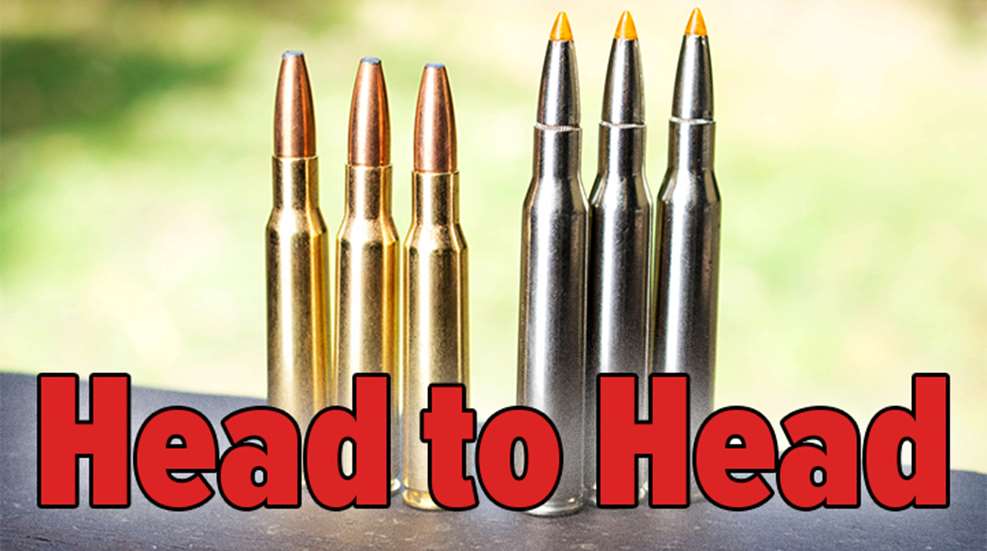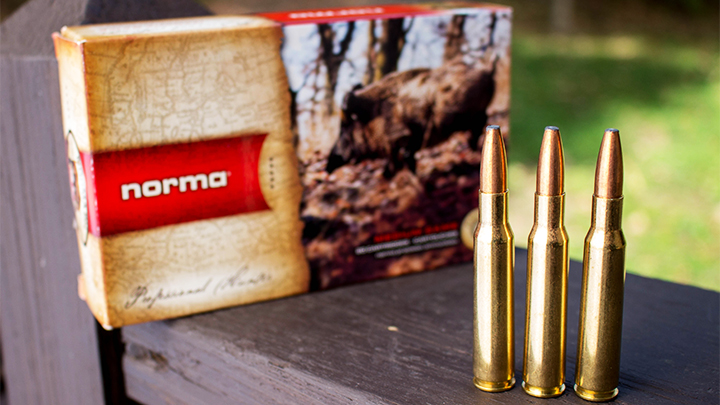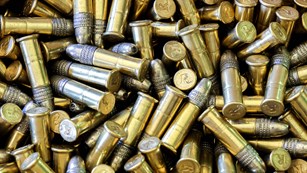
Two classic 7mm cartridges, both with well-established reputations as all-around choices for general big game hunting, and both with a fair number of devotees. In the 7mm bore diameter, these are both middle of the road choices, giving the shooter enough horsepower to get the job done, yet both are usually easy enough on the shoulder to allow for accurate shot placement. Some may say that the pair have both seen better days, with the 7mm Remington Magnum, 7mm-08 Remington, .280 Ackley Improved and 28 Nosler seeming more attractive to new hunters and shooters.

Whether shopping for a new rifle, for perusing the used shelves of your favorite gun shop, you may very well come across a rifle in one of these cartridges, so let’s do a bit of comparing and contrasting between them. This will be a tough one, as they are both excellent designs, with long histories of great field performance.
Looking at the elder cartridge, the 7x57mm Mauser began life as a military cartridge, and went on to inspire America’s sweetheart, the .30-06 Springfield. The 7x57mm Mauser is the brainchild of Peter Paul Mauser, developed in 1892, and was adopted by the Spanish Military a year later. Using a rimless, bottlenecked case measuring 57mm (2.244 inches) and a bullet diameter of 7.25mm (0.284 inches)—the land diameter is where the 7mm moniker is derived—the Mauser design used a 173- to 175-grain round nose bullet at a muzzle velocity of 2300 fps. The switch would later be made to the 139-grain spitzer bullet at a much higher velocity, though the heavier bullet—and the Mauser rifle—made the 7x57mm Mauser’s reputation in the hunting fields. At the turn of the 20th Century, with smokeless powder quickly replacing blackpowder, and jacketed bullets extending the terminal performance, the boundaries of acceptable cartridges were being developed and broken as technology progressed.

In the hands of explorer/hunters like Walter Dalrymple Maitland Bell, known by his African nickname “Karamoja,” the 7x57mm Mauser—marketed in the U.K. as the .275 Rigby—would be used as an all-around cartridge, for animals as small as impala all the way up to elephant. Bell took over 1,000 elephants in his career, and a good percentage of them were with a .275 Rigby and 175-grain solid (non-expanding) bullets. Among many of the East African settlers, the sheer availability of both rifles and ammunition were good reason for using the cartridge on nuisance animals like lion, leopard and the plentiful antelope. Few would consider the 7x57 a good choice for elephant or Cape buffalo, but it does make a great choice for deer, elk, black bear and a good number of the African plains game species. In the High Velocity guise—the throat of the chamber is modified to work best with the 140-grain bullets—as is so popular in the U.K. for stalking red deer and hunting roe deer, the cartridge handles those species perfectly. Our modern bullets have done nothing but help the 19th century cartridge, making it even more effective than it was in the 1890s.

After the Spanish-American War of the late 1890s, our military was forced to re-examine the .30-40 Krag; ultimately the influence of the 7x57mm Mauser gave rise to the .30-06 Springfield that we still hold so dear. They share the same case head diameter, and though the Springfield case is longer, there is no denying the resemblance. The .30-06, and its older brother the .30-03, were necked up and down to hold bullets of many different diameters—think about the famous .270 Winchester, .25-06 Remington and .35 Whelen—but Remington released their .280 Remington in 1957. It is the success of the 7x57mm Mauser which has caused so many cartridges to be necked up or down to hold 7mm bullets; the .280 Remington is no exception. In fact, the .280 Remington may be one of the best balanced of the Springfield family. It did, for the first few decades of its existence, suffer from the incredible popularity of both the .30-06 Springfield and the .270 Winchester, and went through that weird name change debacle in the late 70s/early 80s when it was known as the 7mm Express Remington. However, many gunwriters and hunters alike quietly went about loving the way the .280 Remington performed.

The .280 Remington retains the same 17-degree 30-minute shoulder of the .30-06 but uses the 2.54-inch case of the .30-03 Springfield. It will offer a velocity advantage of about 300 fps or so over the 7x57mm Mauser with most bullet weights, and the most popular choice for the .280 Remington seems to be the 140-, 150- and 160-grain slugs. Most major ammunition manufacturers offer at least one load for the .280 Remington, though it does still trail behind the .270 and .30-06.
Which of these gets the nod? Does the old 7x57 offer enough to make a hunter choose it over the .280? Taking the nostalgia out of the equation, the .280 Remington makes more sense, or perhaps I should say is more versatile for the one-gun hunter. The case capacity and velocities generated by the .280 Remington make is a great choice for those who want the capability to take elk at 400 yards, bear over bait at 40 yards, and everything in between. It is a flat-shooting cartridge, and though it does have more recoil than does the Mauser, it’s very user-friendly. That said, the 7x57mm Mauser can be a very versatile cartridge as well. With the Hornady Custom .275 Rigby load 140-grain load moving at 2680 fps, it will still retain over 1,000 ft-lbs at the 400-yard mark. The 175-grain loads have actually received a bit of a boost over the years, with muzzle velocities in excess of 2400 fps, and are as effective, if not more, than what Karamoja had. I like the Norma 156-grain Oryx load at a muzzle velocity of 2641 fps, as that bullet had proven to be wonderfully accurate and I’m a fan of that bullet’s terminal performance.

Forced to pick between the two, the .280 gives more versatility and the sensible side of me will have to give the .280 Remington the nod. But if you enjoy the historical ties to cartridges, and your shots stay inside of 300 yards, there’s no reason to say no to the 7x57mm Mauser; it just doesn’t have the capability of the .280 Remington at longer ranges.
Looking for previous installments of our "Head to Head" series? We've got you covered.
• .300 Win. Mag. vs. .300 Wby. Mag.
• .375 Ruger vs. .375 H&H Magnum
• 7mm-08 Remington vs. .280 Remington
• .280 Remington vs. .280 Ackley Improved
• 7mm vs. .30 Caliber
• 6.5 Weatherby RPM vs. 6.5 PRC
• .338 Win. Mag. vs. .340 Wby. Mag.
• .300 RSAUM vs. .300 WSM
• .500 Jeffrey vs. .505 Gibbs
• 7mm RUM vs. .300 RUM
• .308 Winchester vs. 7mm-08 Remington
• 6.5 Creedmoor vs. .260 Remington
• .303 British vs. 8x57 Mauser
• .30-06 Springfield vs. All Other .30s
• .17 HMR vs. .17 WSM
• .450 Nitro Express vs. .470 Nitro Express
• 350 Legend vs. .35 Remington
• .280 Ackley Improved vs. 7mm Rem. Mag.
• .404 Jeffery vs. .416 Rigby
• .243 Winchester vs. 6mm Creedmoor
• .300 PRC vs. .300 Win. Mag.
• .30-06 Springfield vs. .270 Winchester
• 6.5 Creedmoor vs. 7mm-08 Remington
• 8x57 Mauser vs. .318 Westley Richards
• .358 Winchester vs. .350 Remington Magnum
• .22-250 Remington vs. .220 Swift
• .270 Winchester vs. .270 WSM
• .26 Nosler vs. 6.5-300 Weatherby Magnum
• .458 Win. Mag. vs. .458 Lott
• 7mm Rem. Mag. vs. .300 Win. Mag.
• .243 Winchester vs. 6mm Remington
• 7x57mm Mauser vs. 7mm-08 Remington
• .25-06 Remington vs. .257 Weatherby Magnum
• .338 Winchester vs. .375 H&H Magnum
• .30-30 Winchester vs. .35 Remington
• .257 Roberts vs. .250-3000 Savage
• .270 Winchester vs. .280 Remington
• .35 Whelen vs. 9.3x62mm Mauser
• .416 Rigby vs. .416 Remington Magnum
• .308 Winchester vs. .30-06 Springfield
• .22 Nosler vs. .224 Valkyrie
• .300 Win. Mag. vs. .300 WSM
• .223 Remington vs. .22-250 Remington



































